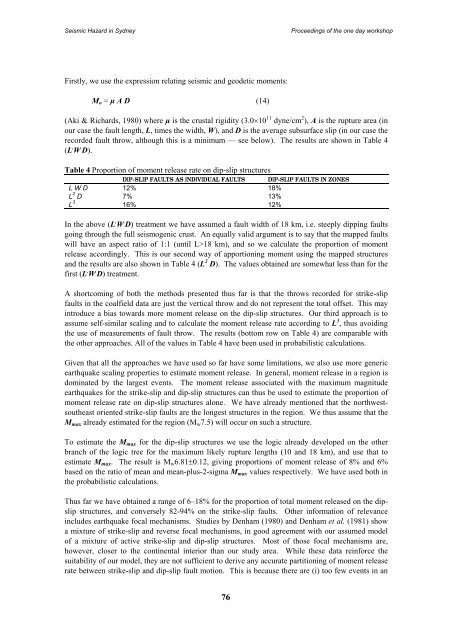Landslides in the Sydney Basin - Geoscience Australia
Landslides in the Sydney Basin - Geoscience Australia
Landslides in the Sydney Basin - Geoscience Australia
- No tags were found...
You also want an ePaper? Increase the reach of your titles
YUMPU automatically turns print PDFs into web optimized ePapers that Google loves.
Seismic Hazard <strong>in</strong> <strong>Sydney</strong>Proceed<strong>in</strong>gs of <strong>the</strong> one day workshopFirstly, we use <strong>the</strong> expression relat<strong>in</strong>g seismic and geodetic moments:M o = µ A D (14)(Aki & Richards, 1980) where µ is <strong>the</strong> crustal rigidity (3.0×10 11 dyne/cm 2 ), A is <strong>the</strong> rupture area (<strong>in</strong>our case <strong>the</strong> fault length, L, times <strong>the</strong> width, W), and D is <strong>the</strong> average subsurface slip (<strong>in</strong> our case <strong>the</strong>recorded fault throw, although this is a m<strong>in</strong>imum — see below). The results are shown <strong>in</strong> Table 4(L . W . D).Table 4 Proportion of moment release rate on dip-slip structuresDIP-SLIP FAULTS AS INDIVIDUAL FAULTS DIP-SLIP FAULTS IN ZONESL W D 12% 18%L 2 D 7% 13%L 3 16% 12%In <strong>the</strong> above (L . W . D) treatment we have assumed a fault width of 18 km, i.e. steeply dipp<strong>in</strong>g faultsgo<strong>in</strong>g through <strong>the</strong> full seismogenic crust. An equally valid argument is to say that <strong>the</strong> mapped faultswill have an aspect ratio of 1:1 (until L>18 km), and so we calculate <strong>the</strong> proportion of momentrelease accord<strong>in</strong>gly. This is our second way of apportion<strong>in</strong>g moment us<strong>in</strong>g <strong>the</strong> mapped structuresand <strong>the</strong> results are also shown <strong>in</strong> Table 4 (L 2 D). The values obta<strong>in</strong>ed are somewhat less than for <strong>the</strong>first (L . W . D) treatment.A shortcom<strong>in</strong>g of both <strong>the</strong> methods presented thus far is that <strong>the</strong> throws recorded for strike-slipfaults <strong>in</strong> <strong>the</strong> coalfield data are just <strong>the</strong> vertical throw and do not represent <strong>the</strong> total offset. This may<strong>in</strong>troduce a bias towards more moment release on <strong>the</strong> dip-slip structures. Our third approach is toassume self-similar scal<strong>in</strong>g and to calculate <strong>the</strong> moment release rate accord<strong>in</strong>g to L 3 , thus avoid<strong>in</strong>g<strong>the</strong> use of measurements of fault throw. The results (bottom row on Table 4) are comparable with<strong>the</strong> o<strong>the</strong>r approaches. All of <strong>the</strong> values <strong>in</strong> Table 4 have been used <strong>in</strong> probabilistic calculations.Given that all <strong>the</strong> approaches we have used so far have some limitations, we also use more genericearthquake scal<strong>in</strong>g properties to estimate moment release. In general, moment release <strong>in</strong> a region isdom<strong>in</strong>ated by <strong>the</strong> largest events. The moment release associated with <strong>the</strong> maximum magnitudeearthquakes for <strong>the</strong> strike-slip and dip-slip structures can thus be used to estimate <strong>the</strong> proportion ofmoment release rate on dip-slip structures alone. We have already mentioned that <strong>the</strong> northwestsou<strong>the</strong>astoriented strike-slip faults are <strong>the</strong> longest structures <strong>in</strong> <strong>the</strong> region. We thus assume that <strong>the</strong>M max already estimated for <strong>the</strong> region (M w 7.5) will occur on such a structure.To estimate <strong>the</strong> M max for <strong>the</strong> dip-slip structures we use <strong>the</strong> logic already developed on <strong>the</strong> o<strong>the</strong>rbranch of <strong>the</strong> logic tree for <strong>the</strong> maximum likely rupture lengths (10 and 18 km), and use that toestimate M max . The result is M w 6.81±0.12, giv<strong>in</strong>g proportions of moment release of 8% and 6%based on <strong>the</strong> ratio of mean and mean-plus-2-sigma M max values respectively. We have used both <strong>in</strong><strong>the</strong> probabilistic calculations.Thus far we have obta<strong>in</strong>ed a range of 6–18% for <strong>the</strong> proportion of total moment released on <strong>the</strong> dipslipstructures, and conversely 82-94% on <strong>the</strong> strike-slip faults. O<strong>the</strong>r <strong>in</strong>formation of relevance<strong>in</strong>cludes earthquake focal mechanisms. Studies by Denham (1980) and Denham et al. (1981) showa mixture of strike-slip and reverse focal mechanisms, <strong>in</strong> good agreement with our assumed modelof a mixture of active strike-slip and dip-slip structures. Most of those focal mechanisms are,however, closer to <strong>the</strong> cont<strong>in</strong>ental <strong>in</strong>terior than our study area. While <strong>the</strong>se data re<strong>in</strong>force <strong>the</strong>suitability of our model, <strong>the</strong>y are not sufficient to derive any accurate partition<strong>in</strong>g of moment releaserate between strike-slip and dip-slip fault motion. This is because <strong>the</strong>re are (i) too few events <strong>in</strong> an
















